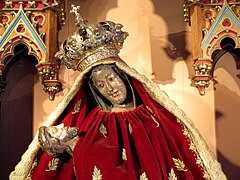This article has multiple issues. Please help improve it or discuss these issues on the talk page. (Learn how and when to remove these messages)
|
| Basilica of Notre-Dame, Marienthal Basilique Notre-Dame de Marienthal | |
|---|---|
 | |
| 48°46′46.24″N 7°49′01.23″E / 48.7795111°N 7.8170083°E / 48.7795111; 7.8170083 | |
| Location | Haguenau |
| Country | France |
| Denomination | Catholic |
| Website | http://basiliquemarienthal.fr/ |
| History | |
| Status | Minor basilica (since 1892) |
| Founded | 1250 |
| Founder(s) | Albert of Haguenau |
| Dedication | Mary, mother of Jesus |
| Architecture | |
| Functional status | Pilgrimage church |
| Architectural type | basilica |
| Style | Gothic Gothic Revival |
| Groundbreaking | 1863 |
| Completed | 1866 |
| Administration | |
| Archdiocese | Archdiocese of Strasbourg |
| Parish | paroisse Saint Joseph de Marienthal |
The Basilica of Notre-Dame, Marienthal (French: Basilique Notre-Dame de Marienthal), is a Catholic pilgrimage church dedicated to Mary, mother of Jesus. Located in Marienthal, in the Bas-Rhin department of France, it is administratively situated in the town of Haguenau.
Pope Pius IX crowned the dolorous Marian image enshrined within in 1859. Pope Leo XIII elevated the status of the shrine to Minor basilica in 1892.
The first sanctuary at this site was built around 1250 by the knight Albert of Haguenau (died in 1254), who had had a religious epiphany some ten years prior and had gathered a small community of faithful around him. This first sanctuary, called "Mary in the Valley", venerated a statue of the Madonna and Child which is not preserved today. The two statues that are venerated today, a Madonna and Child and a Pietà, date from the early 15th century. In the 18th century, the basilica also received precious gifts from queen consort Marie Leszczyńska.
The current, spacious church was built in 1863–1866 in the Gothic Revival style, but keeps a Late Gothic sacristy from 1519, decorated with early Renaissance bosses, and elaborate works of art such as a Dormition of Virgin Mary, and an Entombment of Christ, carved in sandstone by the local master sculptor, Friedrich Hammer (also known as Fritz Hammer, or Frédéric Hammer). Among the 19th-century works of art in the basilica figures a set of frescoes by Martin von Feuerstein (1889).
Gallery
-
West facade
-
Steeple
-
 Interior, looking east
Interior, looking east
-
 Interior, looking west
Interior, looking west
-
Madonna and Child
-
 Pietà (Canonically Crowned, 19 September 1859, PP. Pius IX)
Pietà (Canonically Crowned, 19 September 1859, PP. Pius IX)
See also
References
- "9. XIXe : un siècle de gloire". basiliquemarienthal.fr. Retrieved 14 May 2019.
- "1. Albert de Haguenau, fondateur de " Mariæ in valle "". basiliquemarienthal.fr/. Retrieved 14 May 2019.
- "3. Début du XVème siècle : origine des 2 statues de la Vierge". basiliquemarienthal.fr. Retrieved 14 May 2019.
- "7. Maria Leszinska, reine de France : sa dévotion à Notre-Dame de Marienthal". basiliquemarienthal.fr. Retrieved 14 May 2019.
- "2. 1257-1543 : une communauté de moines guillelmites dynamiques". basiliquemarienthal.fr. Retrieved 14 May 2019.
- "La basilique Notre-Dame-des-Douleurs de Marienthal à MARIENTHAL (67)". petit-patrimoine.com. Retrieved 14 May 2019.
